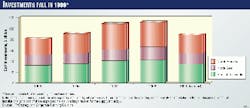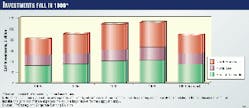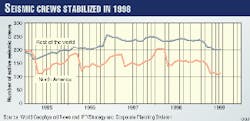WORLDWIDE REVIEW-1
Low crude prices in the spring of 1998 caused oil companies to tighten the reins on investments in 1999. Investments in all parts of the oil industry, from exploration to refining, felt the reverberating effects of this crash.
This article, based on a study by IFP published in December 1999, documents the effects of the crash on industry investment.
After a difficult period, investment levels for exploration and production will recover in the year 2000. Investment in the refining sector, on the other hand, suffered in 1998 and 1999 and will remain low in 2000.
In a review of the past 2 years, upstream activities reached a record level in 1998. The oil crisis in the first half of 1998, however, forced operators drastically to lower their capital expenses in 1999. The volume of service activities in 1999 decreased by:
- 20% in geophysics.
- 25% in drilling.
- 30-45% in the construction of offshore equipment.
In parallel, oil companies initiated unprecedented mergers and acquisitions to reduce their costs and increase the profitability of their operations.
The number of clients in the service industry diminished as operators put pressure on them to reduce their margins. These elements led contractors not only to control costs but also to seek out a critical size in their markets.
This is the first in a series of three articles documenting the worldwide activity in the oil and gas industry in the past 2 years.
This article covers the exploration and production sectors. The second article will be a summary of drilling activity around the world. The third article will cover the refining sector.
Numbers in this article do not take into account former centrally planned economy countries for which estimates of expenses and levels of activity are difficult to calculate.
Investments
In 1998, investments reached a record level of $111 billion. Growth rates, however, slowed to 3%, compared to growth rates of 10-20% in the past 3 years. Thus, 1998 marked the end of a steady expansion cycle of capital expenditures by oil companies.
From 1994 to 1998, upstream investments in the oil chain grew by 56%, an average annual growth rate of 12%.
Fig. 1 summarizes these statistics.
It seems paradoxical that oil prices fell by 33% in 1998 without an apparent effect on the investments made by operators. This contradiction can be explained as follows:
- Oil companies drew up their investment budget for 1998 in 1997, using hypotheses developed around much more optimistic oil prices than reality.
- Operators wondered about the sustainability or possible turnaround of this situation but only mildly adjusted their exploration-production expenditures during the year. In addition, technical reasons or contractual obligations make it difficult suddenly to change scheduled work.
Areas touched by worldscale projects, such as those in the North Sea, West Africa, and Latin America, saw a great increase in investments in 1998.
On the other hand, for the first time since 1992, investments dropped in North America, where independent companies now run a large part of the upstream activity. Since these companies work on smaller developments, they are more sensitive to variations in energy prices than the majors. As a result of reductions in their cash flow, some of them lowered their expenses in the second half of the year.
In 1999, oil companies drastically reacted to the continued low prices of oil observed throughout 1998. As a result, IFP estimates that investments were cut by 22% in 1999 to $87 billion, marking the greatest reduction since 1986.
North America was the hardest hit with a decrease of 27%. Investment in the North Sea also slowed down by 14%, as the drop in the price of crude compromised the profitability of many projects in this area with traditionally high production costs.
In the rest of the world, national companies, namely those countries belonging to the Organization of Petroleum Exporting Countries (OPEC), postponed extension programs of their production capacity as a result of a decrease in their financial resources.
OPEC's decision to postpone production programs, accompanied by kept commitments, resulted in a doubling of oil prices between April and September.
Despite higher oil prices, the majors are not considering any upward changes in investment as they maintain a policy of sustained reductions in expenses and a focus on exploration. Some companies have undertaken, directly or through mergers, substantial cost-reduction programs.
Only a handful of independent North American companies announced an increase in their investments for the second half of 1999. Their efforts, however, were focused on enhancing the value of existing prospects rather than exploring new areas.
In 2000, the upstream sector will grow again, thanks to a recovery in the balance of the oil markets. In fact, according to the International Energy Agency, Paris, world oil demand will increase by 2.4% in 2000 compared with 1.3% in 1999. Quicker depletion of fields could provoke a drop in non-OPEC production.
Uncertainty as to whether the members of OPEC will continue to regulate production will incite oil companies to be rather cautious. In addition, mergers between companies will have a short-term impact on investments, which is hard to evaluate today.
In 2000, capital expenditures in the exploration and production areas will take off again but will not approach either 1997 or 1998 levels.
Weak geophysics sector
As the first link in the oil chain, the geophysical sector is the one most affected by any variation in the level of operator investments.
On a world scale, the number of active seismic teams in 1998 stabilized at 408 units, after having grown steadily for 2 years (Fig. 2). North America had about 168 crews, and the rest of the world had about 240.
These numbers, however, conceal substantial regional disparities. In fact, most geographical areas experienced a significant fall in their seismic activity in 1998. Only Africa and North America registered respective rises of 10% and 15%, mainly as a result of the mobilization of offshore seismic teams in the Gulfs of Guinea and Mexico.
In 1999, the situation was different. An analysis of the first 7 months of the year shows a general drop in oil prospecting. This decrease was particularly brutal in Canada (-41%), Latin America (-25%), and the US (-16%). The only area which resisted this depression was Africa, where demand for deepwater prospecting was higher in 1999 than in 1998.
In July 1999, the number of active seismic teams stopped falling and stabilized at around 310 units. If this stability held throughout the remainder of 1999, the number of teams will have dropped by 20% in 1999.
The geophysical service market was $5.2 billion in 1998, representing a 15% rise over 1997. For 1999, the estimated sales volume brought in by contractors was between $3.1 and $3.4 billion, representing a shrinking volume of 35-40% resulting from two phenomena:
- A setback in the seismic activity mentioned above, or the "volume effect" (-20%).
- A drop in the rates of service companies, or the "price effect" (-15 to -20%).
The weak demand has placed great pressure on seismic-campaign prices. The context was even worse in the offshore sector since eight ultra-modern ships were added to the world fleet in 1999.
In parallel, for several years now, there has been a large development of speculative or multiclient acquisitions of offshore seismic data which, in 1998, represented close to 40% of covered surfaces. This type of contract enables the contractor to sell the same studies to several oil companies who then get a discounted price, given that there is a loss in data exclusivity.
In 1999, most of these nonexclusive campaigns continued to increase and represented more than half the activity of geophysical companies. In this market segment, the situation is also gloomy, especially since mergers and acquisitions undertaken by the majors or the independent oil companies reduce the number of potential clients.
Players in the market for acquisitions and the processing of seismic data had a difficult time in 1999. Some of them are in poor financial situations, making them likely to file for bankruptcy or be bought out by competitors.
The market is dominated by five companies which control over 80% of the activity: Baker Hughes Inc., Schlumberger Ltd., Petroleum Geo-Services (PSG), Compagnie Generale de Geophysique (CGG), and Veritas DCG.
The first signs of a stabilization in the activity were seen at the end of 1999 but still need to be confirmed. A significant recovery in the demand cannot be considered without there first being an increase in exploration investments.
Construction of offshore equipment
In terms of offshore developments, 1997 was a record year for the decade.
In 1998, whereas the activity did not reach this exceptional level, it nevertheless remained steady. Between 1997 and 1998, there was a drop in the installation of floating systems (-20%), pipelines (-6%), and fixed platforms (-4%). On the other hand, the market for subsea completions continued to grow (+10%).
This trend shows that there is stability in the construction of fixed structures in shallow seas and increasing interest in deep offshore areas with large reserve potential. This is the case in the Gulf of Mexico, Brazil, the North Sea, and the Gulf of Guinea.
An overview of activity in June 1999, compared to June 1998 (Table 1), shows that the amount of equipment under construction dropped substantially in every region of the world (-26%).
The volume of manufactured subsea completions was the most affected; it posted a drop of 45% following slower activity in the North Sea. The volume for fixed or floating platforms decreased by about 30%; the regions most affected were Asia, the Middle East, and Western Europe.
On the other hand, pipeline activity posted remarkable growth of 67%, largely on account of Latin America.
In the first 7 months of 1999, the number of installed floating supports reached a total of seven, compared with one support for the same period in 1998. The laying of pipelines held steady and only fell by 8%.
On the other hand, the installation of fixed platforms and subsea completions greatly suffered with respective falls of 20% and 70%.
Compared with June 1998, the number of construction projects identified in June 1999 dropped by 15% for pipelines, 6% for subsea completions, and 3% for all types of platforms.
Operators put aside their development decisions but did not abandon them. An improvement in the economic situation could switch these opportunities from the project phase to a construction phase.
The Authors
Christophe Armengol joined the strategy and corporate planning division of IFP in 1995. He is a market analyst, specializing in upstream economic issues. Previously, he worked for 2 years on environmental problems in the oil sector at Centre National de la Recherche Scientifique, Paris.
Armengol holds an MS in chemical engineering from Ecole Nationale Supérieure d'Ingénieurs de Génie Chimique, Toulouse, and holds an MS in process engineering from Institut National Polytechnique, Toulouse.
Jöelle Germain is a market analyst in the strategy and corporate planning division of Institut Français du Pétrole (IFP). She joined IFP in 1996 where she specializes in upstream economic issues and research and development evaluation.
Germain holds an MS in mechanics from Ecole Nationale Supérieure d'Arts et Métiers, Paris, and a degree in economics and management in the hydrocarbon industry from IFP School, Rueil Malmaison.







